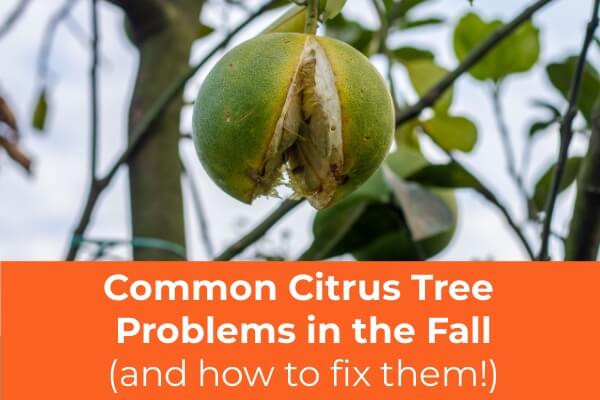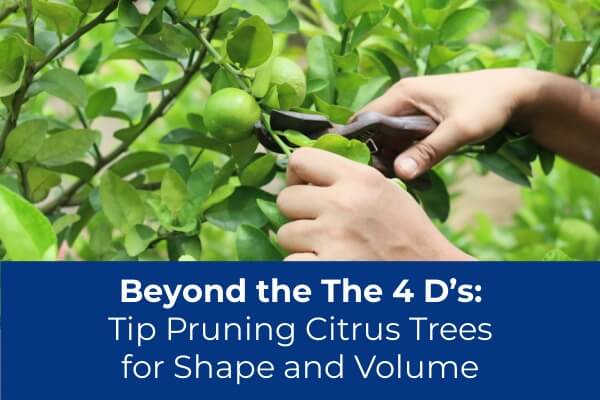Table of Contents
Common Citrus Tree Problems in the Fall (and how to fix them!)
The garden may be quiet in the fall, but it is still an important season for citrus tree growers. After the busy activity of summer, our citrus trees begin to slow down in preparation for colder weather. This may be a time when you start to see the most changes on your trees. Leaves may start to lose their green and start yellowing, fruit may drop or even split, and growth seem to slow way down. All of these fall changes are totally normal once you understand the yearly cycle of citrus trees in your climate.
Take some time to observe and adjust to the needs of your trees this time of year. It is normal for them to show some stress as they adjust to the temperature changes. Here are the most common citrus tree problems in the fall, and how to fix them so that your tree stays strong, healthy and ready to thrive once spring returns next year.
1. Yellowing Leaves
It is common for citrus tree leaves to turn yellow in the fall. As the days get shorter and soil temperatures start to get colder, your tree will naturally slow down its nutrient uptake. That means even if nutrients are available in the soil, the roots may not be able to absorb them as efficiently as in the spring and summer.
How to fix it:
We do not recommend that you fertilize your citrus tree during the fall and winter months, because new growth may be susceptible to dieback from frost. However, you can help your tree by being proactive in the summer. Be sure to keep your tree healthy and thriving with regular fertilizing and provide a chunky, well-draining, nutrient-rich potting soil mix for the tree to draw upon for the rest of the year.
Check your watering schedule. Citrus trees need less water in the colder fall and winter months. They will also be absorbing water at a slower pace, so only water when the top 2" of the soil are dry and it's damp underneath.
2. Leaf Drop
Some shedding of citrus leaves is normal in the fall. As the days get shorter and the nights start to cool down, your tree may drop older leaves to conserve it's energy. Heavy leaf drop, however, is an indication of stress and your tree's way of telling you that something is wrong. Possible reasons for leaf drop could be inconsistent watering, sudden temperature swings, or the trunk of your tree is buried too deeply.
How to fix it:
Water deeply but less frequently. In-ground citrus should be watered when the soil feels dry about 3" down. Container citrus should be watered when the top 2" of the soil is dry and underneath is moist or damp.
Avoid pruning or fertilizing right before a cold spell as both of these can stimulate tender new growth that’s vulnerable to frost.
If your tree is in a container, bring it close to a south-facing wall or patio area for protection once nighttime temperatures dip below 40°F.
Check the depth at which your tree is planted. You should have the crown of the roots just at the soil line, visible to your eyes. If your tree is buried too deeply, it can negatively affect the root growth and also its ability to take up nutrients.
Keep the environment around your tree stable to help it hold onto more leaves and transition smoothly into winter dormancy.
3. Fruit Drop or Splitting
Another common citrus tree problem in the fall is fruit drop and fruit splitting. Fruit splitting is when the rind bursts open or cracks and shows the inside of the fruit.
Both of these issues happen because of uneven watering or sudden changes is temperature. Uneven fluctuations in temperature can cause the fruit to expand and contract too quickly and cause it to split. Also, fruit may split if there is a heavy rain or deep watering after a period of no water. This sudden intake in water happened before the fruit has a chance to adjust to a bigger size.
How to fix it:
Keep your watering schedule consistent, even as temperatures cool. Dry spells followed by a sudden soaking are the main culprits behind fruit splitting, so maintain a moist level of potting soil.
In cold areas, apply a thin layer of mulch around the base of your tree to help regulate soil moisture.
Splitting won’t harm your tree, but it can make fruit more susceptible to rotting, so be sure to harvest any damaged fruit right away.
4. Curling Leaves or Sticky Residue
Cooler weather can sometimes bring a mild resurgence of pests like aphids, scale, and whiteflies. You’ll know they’re around when you see curling leaves, sticky residue (called honeydew), or a faint sooty mold on the leaves. These pests suck sap from the leaves and can cause stunted growth if not managed.
How to fix it:
Spray the leaves with a strong stream of water to knock pests off.
Apply horticultural oil or insecticidal soap early in the morning, coating both sides of the leaves.
Good airflow deters pest buildup, so thin out crowded branches or criss-crossing branches.
If your citrus tree is in a greenhouse, sunroom, or indoors, pests can multiply faster due to the warm enclosed environment. Regular inspections and getting ahead of it are your best defense.
5. Cold Damage or Frost Stress
As temperatures dip, citrus trees can suffer from frost damage. This is especially true for young trees or if they are still pushing tender new growth. Citrus are generally frost sensitive, so even a light frost can cause leaf curling, browning, or dieback at the tips.
How to fix it:
Move container citrus under cover or near a sunny wall where radiant heat offers protection.
Use frost cloths, old sheets, or blankets to cover trees on cold nights, removing them during the day for sunlight.
Avoid feeding in late fall. Fertilizing encourages new, soft growth that’s more sensitive to frost.
If frost damage does occur, resist the urge to prune right away. Wait until spring, when new growth emerges, so you can clearly see which branches are truly dead.
6. Root Rot
Fall’s cooler, wetter weather can trigger root rot, which is one of the more serious citrus tree problems. When soil stays soggy for too long, fungal pathogens like Phytophthora thrive, leading to weak, yellowing trees with poor growth.
How to fix it:
Always check that pots have proper drainage holes.
When repotting, use a mix that drains quickly, like DIY Primo Potting Soil, which keeps roots healthy and oxygenated.
Water only when the top two inches of soil feel dry. Each season you will be watering your tree onna different schedule.
If you suspect root rot, remove the tree from its container, trim away black or mushy roots, and replant in fresh, well-draining soil. Prevention is the key, as root rot is much easier to avoid than to cure.
7. Slow or Stalled Growth
Citrus trees naturally slow their growth in fall, but new gardeners sometimes mistake this pause for a problem. During shorter days, trees divert their energy from producing leaves and fruit to strengthening their root systems.
How to fix it:
Don’t overfeed or overwater in an attempt to “wake it up.”
Focus on maintaining even moisture and protecting the tree from frost.
When spring arrives, you’ll see a burst of new growth as your tree rewards your patience.
Most fall citrus tree problems are simply signs that some adjustment is needed. Your tree is responding to cooler weather, shorter daylight, and changing soil conditions, which are all normal parts of its seasonal rhythm. The key is knowing what’s natural and what needs intervention.
A few simple habits like checking for proper drainage and keeping consistent watering go a long way when it comes to keeping your tree happy.
Fall is also the perfect time to plan for next year. Take note of what worked and what didn’t this season.
At Four Winds Growers, we believe fall is when thoughtful gardeners become great growers. With a little observation and care now, your citrus trees will reward you with fragrant blooms and a bountiful harvest when the warm days return.




